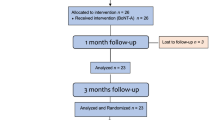Abstract
Purpose
Our objective in this study was to assess the changes in medial gastrocnemius muscle (GCM) stiffness after botulinum toxin A (BTA) injection in children with cerebral palsy (CP) by using acoustic radiation force impulse (ARFI) elastography and to research the usability of this technique in clinical practice.
Materials and methods
Twenty-four spastic lower extremities of 12 children with CP were assessed. BTA injection treatment was applied to the medial GCM. Muscle stiffness was measured with the ARFI technique before the procedure and a month after the procedure. The patients were assessed with the modified Ashworth scale (MAS) in the physiotherapy department at about the same time. Shear wave velocity (SWV) values and MAS scores before and after the treatment were compared.
Results
Mean SWV values were measured as 3.20 ± 0.14 m/s before BTA and as 2.45 ± 0.21 m/s after BTA, and the difference between them was found to be statistically significant (p < 0.001). Mean MAS score (2.33 ± 0.70) after BTA decreased significantly when compared to the score before BTA (2.96 ± 0.62) (p = 0.001). SWV values positively correlated with MAS scores (ρ = 0.578, p = 0.003). The interobserver agreement expressed as interclass correlation coefficient (ICC) was 0.65 (95% CI 0.33–0.84, p < 0.001).
Conclusion
ARFI elastography for identifying structural changes that occur in the spastic muscle after BTA injection in children with CP can yield more valuable information with combined use of MAS.



Similar content being viewed by others
References
Kerr Graham H, Selber P. Musculoskeletal aspects of cerebral palsy. J Bone Jt Surg Br. 2003;85:157–66.
Cosgrove AP, Corry IS, Graham HK. Botulinum toxin in the management of the lower limb in cerebral palsy. Dev Med Child Neurol. 1994;36:386–96.
Langdon K, Blair E, Davidson SA, et al. Adverse events following botulinum toxin type A treatment in children with cerebral palsy. Dev Med Child Neurol. 2010;52:972–3.
Bohannon RW, Smith MB. Interrater reliability of a modified Ashworth scale of muscle spasticity. Phys Ther. 1987;67:206–7.
Yam WK, Leung MS. Interrater reliability of Modified Ashworth Scale and Modified Tardieu Scale in children with spastic cerebral palsy. J Child Neurol. 2006;21:1031–5.
Mutlu A, Livanelioglu A, Gunel MK. Reliability of ashworth and modified ashworth scales in children with spastic cerebral palsy. BMC Musculoskelet Disord. 2008;9:44.
Numanoğlu A, Günel MK. Intraobserver reliability of modified Ashworth scale and modified Tardieu scale in the assessment of spasticity in children with cerebral palsy. Acta Orthop Traumatol Turc. 2012;46:196–200.
Ruan Z, Zhao B, Qi H, et al. Elasticity of healthy Achilles tendon decreases with the increase of age as determined by acoustic radiation force impulse imaging. Int J Clin Exp Med. 2015;15:1043–50.
Brandenburg JE, Eby SF, Song P, et al. Ultrasound elastography: the new frontier in direct measurement of muscle stiffness. Arch Phys Med Rehabil. 2014;95:2207–19.
Fahey BJ, Nightingale KR, Nelson RC, et al. Acoustic radiation force impulse imaging of the abdomen: demonstration of feasibility and utility. Ultrasound Med Biol. 2005;31:1185–98.
Nightingale K. Acoustic radiation force impulse (ARFI) imaging: a review. Curr Med Imaging Rev. 2011;7:328–39.
Kwon DR, Park GY, Lee SU, et al. Spastic cerebral palsy in children: dynamic sonoelastographic findings of medial gastrocnemius. Radiology. 2012;263:794–801.
Boyaci A, Tutoglu A, Boyaci N, et al. Changes in spastic muscle stiffness after botulinum toxin A injections as part of rehabilitation therapy in patients with spastic cerebral palsy. NeuroRehabilitation. 2014;35:123–9.
Lee SMS, Gaebler-Spira D, Zhanga LQ, et al. Use of shearwave ultrasound elastography to quantify muscle properties in cerebral palsy. Clin Biomech. 2016;31:20–8.
Park GY, Kwon DR. Sonoelastographic evaluation of medial gastrocnemius muscles intrinsic stiffness after rehabilitation therapy with botulinum toxin a injection in spastic cerebral palsy. Arch Phys Med Rehabil. 2012;93:2085–9.
Picelli A, Dambruoso F, Bronzato M, et al. Efficacy of therapeutic ultrasound and transcutaneous electrical nerve stimulation compared with botulinum toxin type A in the treatment of spastic equinus in adults with chronic stroke: a pilot randomized controlled trial. Top Stroke Rehabil. 2014;21:S8–16.
Nightingale KR, McAleavey SA, Trahey GE. Shear wave generation using acoustic radiation force: in vivo and ex vivo results. Ultrasound Med Biol. 2003;29:1715–23.
Friedrich-Rust M, Wunder K, Kriener S, et al. Liver fibrosis in viral hepatitis: noninvasive assessment with acoustic radiation force impulse imaging versus transient elastography. Radiology. 2009;252:595–604.
Palmeri ML, Wang MH, Rouze NC, et al. Noninvasive evaluation of hepatic fibrosis using acoustic radiation force-based shear stiffness in patients with nonalcoholic fatty liver disease. J Hepatol. 2011;55:666–72.
Aşkın A, Kalaycı ÖT, Bayram KB, et al. Strain sonoelastographic evaluation of biceps muscle intrinsic stiffness after botulinum toxin-A injection. Top Stroke Rehabil. 2016;23:1–6.
Cho KH, Nam JH. Evaluation of stiffness of the spastic lower extremity muscles in early spinal cord injury by acoustic radiation force impulse imaging. Ann Rehabil Med. 2015;39:393–400.
Booth CM, Cortina-Borja MJ, Theologis TN. Collagen accumulation in muscles of children with cerebral palsy and correlation with severity of spasticity. Dev Med Child Neurol. 2001;43:314–20.
Smith LR, Lee KS, Ward SR, et al. Hamstring contractures in children with spastic cerebral palsy result from a stiffer extracellular matrix and increased in vivo sarcomere length. J Physiol. 2011;589:2625–39.
Author information
Authors and Affiliations
Corresponding author
Ethics declarations
Conflict of interest
The authors have no commercial associations or sources of support that might pose a conflict of interest.
Ethical statement
The study was approved by the Medical Ethics Committee of the University Hospital, and all subjects provided written informed consent.
About this article
Cite this article
Ceyhan Bilgici, M., Bekci, T., Ulus, Y. et al. Quantitative assessment of muscle stiffness with acoustic radiation force impulse elastography after botulinum toxin A injection in children with cerebral palsy. J Med Ultrasonics 45, 137–141 (2018). https://doi.org/10.1007/s10396-017-0780-y
Received:
Accepted:
Published:
Issue Date:
DOI: https://doi.org/10.1007/s10396-017-0780-y




